3G Internet at 33 km
One of my friends, a big fan of the idea of ancestral estates, about a year ago began to settle in his own piece of land, far from villages and cities. He built a wooden house, a bathhouse, organized a farm. I got a beautiful wife, a dog model “Hascoalabai” and a cat, Kusay. And everything seems to be good, you can live and develop, but it's great that there is not enough internet connection - traveling every 70km to the city to read forums on construction, solar energy, gardening, and just chatting with friends online became uncomfortable and costly.
With this problem, he turned to me. I started to solve the problem, specifying the introductory conditions:

Of the financially available Internet access technologies, 3G was chosen, since LTE has not yet reached us, and only one operator offers CDMA EV-DO, which drastically reduces the number of available base stations.
After reviewing the assortment of Chinese and Russian online stores, I picked up two sets.
Cheap:
The Chinese say 25dBi gain, but this figure causes skepticism. For example, the same Antex has a similar antenna with only 17 passport dBi. A cheap five-meter cable will take at least 3 dBi. As a result, at best, 14dBi for 1600r.
')
With maximum CU:
Total KU kit should be ~ 21-22dBi, the total cost - 4045r.
Perhaps someone will say that the difference between 14dBi and 22dBi is only 8 units, why pay so much? But let me remind you that dBi is a logarithmic unit and + 8dBi means a signal power difference 6.3 times.
Therefore, we decided to stay on a more expensive, but more reliable option.
After receiving the ordered cables, the illuminator and the modem, and buying a reflector at a local store, we arrived at the site and started installation. Antenna assembly did not cause any difficulties - the main thing is not to forget two nuances:
As an application for monitoring the signal level, I chose MDMA (Mobile Data Monitoring Application), as the most informative of the tested ones. The modem, of course, was previously unlocked in an online application using the w3bsit3-dns.com method.
In my imagination, setting up an antenna on a BS was a simple and even fun process — you look at the signal level in a special application and note the highest value while your partner defiantly twists the antenna in a circle. Then the antenna is mounted on the wall with fine tuning - and voila! A window in the repository of human knowledge (and photos with cats) is cut through. I did not even carefully study the 3G coverage map. And so set up - just spit!
If the description of our misfortunes bore you, I suggest to go directly to the "Results".

To begin, we decided to try out a rough setting - I am behind the laptop in the house, a friend outside, on the stairs, holding the antenna in my hands and smoothly rotating it.
But here's the miracle - without an antenna, the modem showed a -97dBm signal, with an antenna, at best, it was possible to find -101dBm with an almost constant background of -111dBm. In addition, signal fading happened every time when the level values or SNR (signal / noise) stopped changing or dropped to -125 dBm (the modem cannot show a smaller number). In order to bring the modem back to life, it had to be rebooted. Also, often at the same position, the signal level on the first pass was one, on the next pass a completely different one. All this is very slow work. Sometimes I checked the list of available networks: most often only TELE2 was visible, occasionally Beeline and Megafon.
We spent several hours trying to get directions to the BS, rotating the reflector either from one side of the house or from the other.
Totally to no avail.
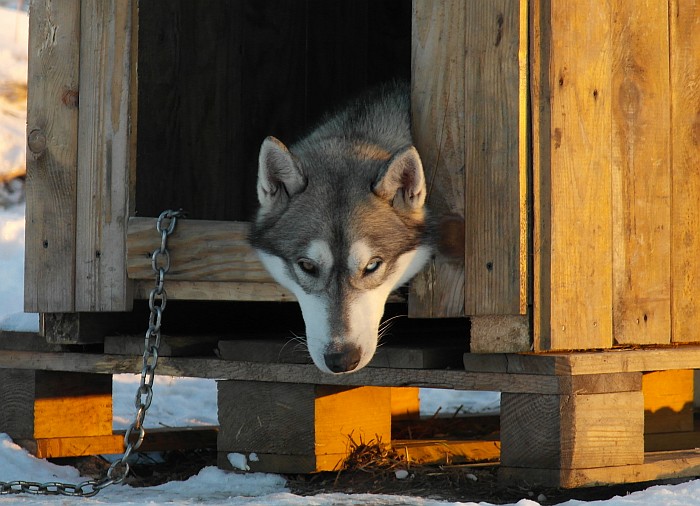
Balu's dog completely lost the hope that the guest would have a chance to speak and finally play with him.
I rechecked all the cable connections and connectors, measured the geometry of the plate, tried to remove the illuminator and move them, trying to find the "downed" focus. To no avail. Then we decided to try to determine the direction of the signal from home, putting the antenna on the stick so that it was easier to turn it precisely. The first stars appeared in the sky, but we still had only a weak, jumping back and forth signal that did not give useful information for tuning to the BS.
The next step was to install the antenna in the complete bracket on the wall of the house - suddenly, without a fixed mount, there is not enough turning accuracy? No sooner said than done. However - here's a surprise - the results of the setup were no different from all other attempts. In desperation, we moved the mount to the opposite wall and repeated the passage of the beam in a semicircle with the same success.
In a dull state of mind and far into the night we went to bed.
Morning brought a new idea - we decided to raise the plate above the roof of the house on a homemade mast. So we, firstly, improve the signal and, secondly, simplify the fine tuning.
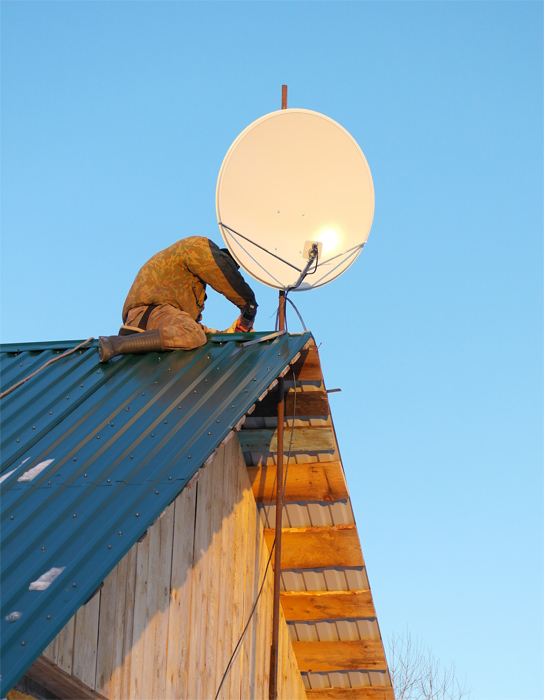
The total length of the mast is 8m.
After installing the antenna, I returned to the laptop. Once again, MDMA looked at the native interface ... And then it dawned on me! After all, I had chosen the Connection type: “3G Prefferred”, that is, the preferred, rather than the exclusive 3G mode!

This also explains everything - and periodic “fading”, when the modem switched modes 3g / 2g, and -97dBm signal without antenna (from TELE2) and other oddities.
With the “3G-Only” mode turned on, the setup went much faster - the modem “hung up” less often, and the background signal level dropped to zero, so turning the reflector towards the BS 3G immediately gave a jump.
However, even with the antenna above the roof, the maximum of the 3G signal, which we received is -109dBm, and this is in the direction of the settlement to which it is only 12km! Weak result for such a large reflector.
I already sadly imagined talking to Anteks, trying to return the kit for testing under warranty, I thought about how much time and nerves it would take. And I decided just to make sure that the signal is disgusting, to connect to the Internet. Surprisingly, the connection was instant. But ping no longer went:

“No wonder,” I thought, “With such a signal.” But wait, if the channel is so unstable, how could the name ya.ru be resolved? I check other names - they are also allowed. I open the browser and immediately directs me to the Beeline stub page, reporting a lack of balance. I connect another sim card - and indeed, there is the Internet! Speedtest.net showed a speed of 2.19mbps incoming and 0.12mbps outgoing channel. Great, now you need a jeweler setting the antenna position.
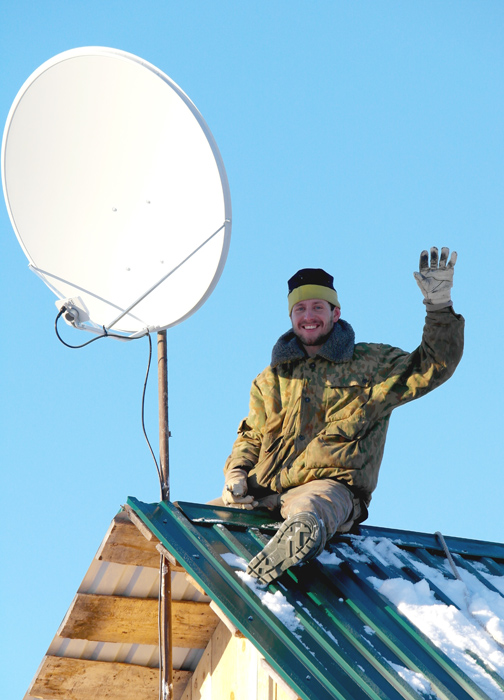
Some more half an hour on the roof - and we managed to raise the signal to -97dBm with SNR = -94!
Compared to the level of the 3G signal without an antenna:
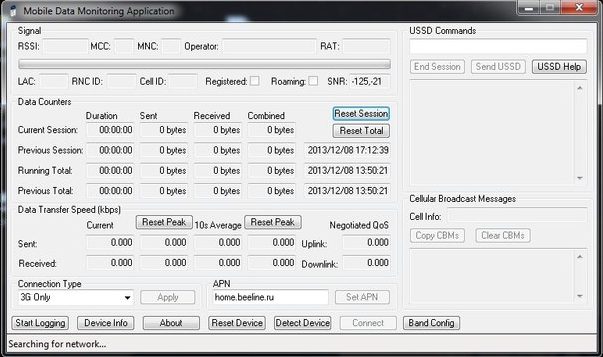
Modem 1.5m from the floor.
With the help of the antenna placed on the mast, it was possible to achieve an increase in the signal level by 28 dBm, or 630 times!

Antenna at a height of 7m.
It was possible to ensure the speed of ~ 5 Mbps downlink and ~ 1 Mbps uplink.

But what is most amusing, looking at Beeline’s 3G coverage map and calling technical support for them, I found out that we actually connected to the BS in the village 33 km from us, and not 12, as we thought at first. Closer Beeline in that direction simply does not have sectors with 3G. For such a distance, I consider the received signal gain good. However, due to the distance, the unpleasant effect of BS breathing manifested itself. When the load on the sector increases, the BS decreases the range, which is why in the evenings the Internet sometimes “falls off” temporarily.
But in any case, the task was completed - my friends got quite fast Internet. And with a clear conscience I could finally play with Balu and get home.

UPD: By the way, after about a week, my friend tweaked the antenna by slightly tilting the dish down. It received a signal of -95dBm, and at night, in torrents, the Internet now accelerates to an incredible 8-10 Mbps downstream.
With this problem, he turned to me. I started to solve the problem, specifying the introductory conditions:
- Of the 3G mobile operators, voice communication only works for Beeline, and then, if you go to the window. TELE2 is still being caught, but it does not have 3G;
- Internet via USB-modem from neighbors loads the average page for 10 minutes;
- The nearest settlement is 7 km, the nearest “large” (28 thousand people) - 30 km;

Equipment selection
Of the financially available Internet access technologies, 3G was chosen, since LTE has not yet reached us, and only one operator offers CDMA EV-DO, which drastically reduces the number of available base stations.
After reviewing the assortment of Chinese and Russian online stores, I picked up two sets.
Cheap:
- Chinese antenna - ~ 700r
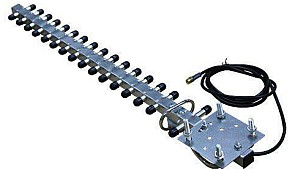
- Huawei E352 modem with antenna input - 900r
The Chinese say 25dBi gain, but this figure causes skepticism. For example, the same Antex has a similar antenna with only 17 passport dBi. A cheap five-meter cable will take at least 3 dBi. As a result, at best, 14dBi for 1600r.
')
With maximum CU:
- Offset reflector for satellite signal Supral, Ø = 0.9m - 1280r
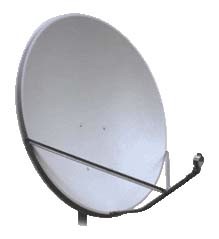
- Irradiator 3G AX-2000 OFFSET (passport CU with reflector 0.9m at least 23dBi) - 940r
- Cable N-Male-> SMA-Male 5D-FB 5m (-1.7dBi) - 625r
- Cable adapter for SMA-Male-> CRC-9 - 300R modem
- Huawei E352 modem with antenna input - 900r
Total KU kit should be ~ 21-22dBi, the total cost - 4045r.
Perhaps someone will say that the difference between 14dBi and 22dBi is only 8 units, why pay so much? But let me remind you that dBi is a logarithmic unit and + 8dBi means a signal power difference 6.3 times.
Therefore, we decided to stay on a more expensive, but more reliable option.
Training
After receiving the ordered cables, the illuminator and the modem, and buying a reflector at a local store, we arrived at the site and started installation. Antenna assembly did not cause any difficulties - the main thing is not to forget two nuances:
- The irradiator is installed in compliance with the direction of polarization (the mark on the body must be vertical);
- To receive a signal propagating parallel to the ground, the reflector plane must be tilted downward to the offset angle relative to the vertical. In our case, the angle was ~ 20 °;
As an application for monitoring the signal level, I chose MDMA (Mobile Data Monitoring Application), as the most informative of the tested ones. The modem, of course, was previously unlocked in an online application using the w3bsit3-dns.com method.
In my imagination, setting up an antenna on a BS was a simple and even fun process — you look at the signal level in a special application and note the highest value while your partner defiantly twists the antenna in a circle. Then the antenna is mounted on the wall with fine tuning - and voila! A window in the repository of human knowledge (and photos with cats) is cut through. I did not even carefully study the 3G coverage map. And so set up - just spit!
Walking around the rake
If the description of our misfortunes bore you, I suggest to go directly to the "Results".

To begin, we decided to try out a rough setting - I am behind the laptop in the house, a friend outside, on the stairs, holding the antenna in my hands and smoothly rotating it.
But here's the miracle - without an antenna, the modem showed a -97dBm signal, with an antenna, at best, it was possible to find -101dBm with an almost constant background of -111dBm. In addition, signal fading happened every time when the level values or SNR (signal / noise) stopped changing or dropped to -125 dBm (the modem cannot show a smaller number). In order to bring the modem back to life, it had to be rebooted. Also, often at the same position, the signal level on the first pass was one, on the next pass a completely different one. All this is very slow work. Sometimes I checked the list of available networks: most often only TELE2 was visible, occasionally Beeline and Megafon.
We spent several hours trying to get directions to the BS, rotating the reflector either from one side of the house or from the other.
Totally to no avail.

Balu's dog completely lost the hope that the guest would have a chance to speak and finally play with him.
I rechecked all the cable connections and connectors, measured the geometry of the plate, tried to remove the illuminator and move them, trying to find the "downed" focus. To no avail. Then we decided to try to determine the direction of the signal from home, putting the antenna on the stick so that it was easier to turn it precisely. The first stars appeared in the sky, but we still had only a weak, jumping back and forth signal that did not give useful information for tuning to the BS.
The next step was to install the antenna in the complete bracket on the wall of the house - suddenly, without a fixed mount, there is not enough turning accuracy? No sooner said than done. However - here's a surprise - the results of the setup were no different from all other attempts. In desperation, we moved the mount to the opposite wall and repeated the passage of the beam in a semicircle with the same success.
In a dull state of mind and far into the night we went to bed.
Morning brought a new idea - we decided to raise the plate above the roof of the house on a homemade mast. So we, firstly, improve the signal and, secondly, simplify the fine tuning.

The total length of the mast is 8m.
After installing the antenna, I returned to the laptop. Once again, MDMA looked at the native interface ... And then it dawned on me! After all, I had chosen the Connection type: “3G Prefferred”, that is, the preferred, rather than the exclusive 3G mode!

This also explains everything - and periodic “fading”, when the modem switched modes 3g / 2g, and -97dBm signal without antenna (from TELE2) and other oddities.
With the “3G-Only” mode turned on, the setup went much faster - the modem “hung up” less often, and the background signal level dropped to zero, so turning the reflector towards the BS 3G immediately gave a jump.
However, even with the antenna above the roof, the maximum of the 3G signal, which we received is -109dBm, and this is in the direction of the settlement to which it is only 12km! Weak result for such a large reflector.
I already sadly imagined talking to Anteks, trying to return the kit for testing under warranty, I thought about how much time and nerves it would take. And I decided just to make sure that the signal is disgusting, to connect to the Internet. Surprisingly, the connection was instant. But ping no longer went:

“No wonder,” I thought, “With such a signal.” But wait, if the channel is so unstable, how could the name ya.ru be resolved? I check other names - they are also allowed. I open the browser and immediately directs me to the Beeline stub page, reporting a lack of balance. I connect another sim card - and indeed, there is the Internet! Speedtest.net showed a speed of 2.19mbps incoming and 0.12mbps outgoing channel. Great, now you need a jeweler setting the antenna position.

Some more half an hour on the roof - and we managed to raise the signal to -97dBm with SNR = -94!
results
Compared to the level of the 3G signal without an antenna:

Modem 1.5m from the floor.
With the help of the antenna placed on the mast, it was possible to achieve an increase in the signal level by 28 dBm, or 630 times!

Antenna at a height of 7m.
It was possible to ensure the speed of ~ 5 Mbps downlink and ~ 1 Mbps uplink.

But what is most amusing, looking at Beeline’s 3G coverage map and calling technical support for them, I found out that we actually connected to the BS in the village 33 km from us, and not 12, as we thought at first. Closer Beeline in that direction simply does not have sectors with 3G. For such a distance, I consider the received signal gain good. However, due to the distance, the unpleasant effect of BS breathing manifested itself. When the load on the sector increases, the BS decreases the range, which is why in the evenings the Internet sometimes “falls off” temporarily.
But in any case, the task was completed - my friends got quite fast Internet. And with a clear conscience I could finally play with Balu and get home.

UPD: By the way, after about a week, my friend tweaked the antenna by slightly tilting the dish down. It received a signal of -95dBm, and at night, in torrents, the Internet now accelerates to an incredible 8-10 Mbps downstream.
Source: https://habr.com/ru/post/206100/
All Articles